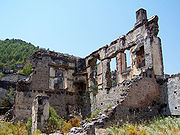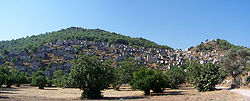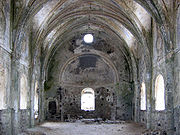
Kayaköy
Encyclopedia


Fethiye
Fethiye is a city and district of Muğla Province in the Aegean region of Turkey with about 68,000 inhabitants .-History:...
in southwestern Turkey
Turkey
Turkey , known officially as the Republic of Turkey , is a Eurasian country located in Western Asia and in East Thrace in Southeastern Europe...
where Anatolia
Anatolia
Anatolia is a geographic and historical term denoting the westernmost protrusion of Asia, comprising the majority of the Republic of Turkey...
n Greek speaking Christians lived until approximately 1923. The ghost town
Ghost town
A ghost town is an abandoned town or city. A town often becomes a ghost town because the economic activity that supported it has failed, or due to natural or human-caused disasters such as floods, government actions, uncontrolled lawlessness, war, or nuclear disasters...
, now preserved as a museum village, consists of hundreds of rundown but still mostly intact Greek-style houses and churches which cover a small mountainside and serve as a stopping place for tourists visiting Fethiye and nearby Ölüdeniz
Ölüdeniz
Ölüdeniz is a small resort village in the Fethiye district which is in the Muğla Province the South West coast of Turkey on the Aegean Sea to the south and the high, steep sided Babadağ Mountain, south of Fethiye. The town is a beach resort.Ölüdeniz remains one of the most photographed beaches on...
.
It was built on the site of the ancient city of Carmylessus in the 18th century. It experienced a renewal after nearby Fethiye (known as Makri) was devastated by an earthquake in 1856 and a major fire in 1885. After the Greco-Turkish War
Greco-Turkish War (1919-1922)
The Greco–Turkish War of 1919–1922, known as the Western Front of the Turkish War of Independence in Turkey and the Asia Minor Campaign or the Asia Minor Catastrophe in Greece, was a series of military events occurring during the partitioning of the Ottoman Empire after World War I between May...
, Kayaköy was largely abandoned after a population exchange
Population exchange between Greece and Turkey
The 1923 population exchange between Greece and Turkey was based upon religious identity, and involved the Greek Orthodox citizens of Turkey and the Muslim citizens of Greece...
agreement was signed by the Turkish and Greek governments in 1923. Many of the buildings were damaged in the 1957 Fethiye earthquake.
Its population in 1900 was about 2,000, almost all Greek Christians; however, it is now empty except for tour groups and roadside vendors selling handmade goods and items scavenged from the former village. However, there are a selection of houses which have been restored, and are currently occupied.

Greek Orthodox Church
The Greek Orthodox Church is the body of several churches within the larger communion of Eastern Orthodox Christianity sharing a common cultural tradition whose liturgy is also traditionally conducted in Koine Greek, the original language of the New Testament...
es, which remain the most important sights of the ghost town. There is a private museum on the history of the town. In the middle of the village stands a fountain source from the 17th century. Kayaköy was adopted by the UNESCO
UNESCO
The United Nations Educational, Scientific and Cultural Organization is a specialized agency of the United Nations...
as a World Friendship and Peace Village.
Economy
Villagers were mostly professional craftsmen. Currently the most important economic factor of the place is tourism, will also be organic farming. It is envisaged that the village will be partially restored.Inspiration
Kayaköy is presumed to be the inspiration behind "Eskibahçe", the imaginary village chosen by Louis de BernièresLouis de Bernières
Louis de Bernières is a British novelist most famous for his fourth novel, Captain Corelli's Mandolin. In 1993 de Bernières was selected as one of the "20 Best of Young British Novelists", part of a promotion in Granta magazine...
as the setting of his 2004 novel Birds Without Wings
Birds Without Wings (novel)
Birds Without Wings is a novel by Louis de Bernières, written in 2004. Narrated by various characters, it tells the tragic love story of Philothei and Ibrahim. It also chronicles the rise of Mustafa Kemal Atatürk, the 'Father of the Turkish Nation'...
.

